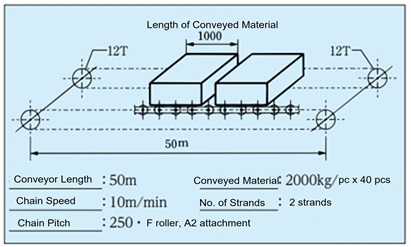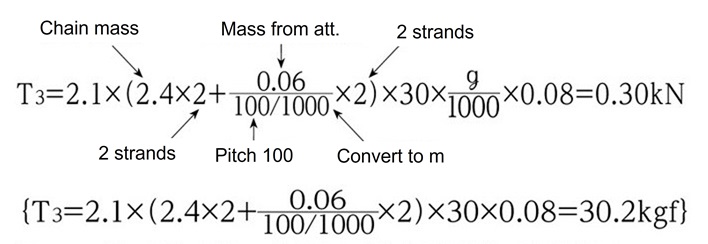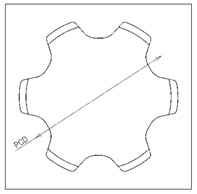Technical Data Large size conveyor chain Selection
10. Selection example
10.1 Bearing roller conveyor chain

We will see selection examples for Bearing Roller Conveyor Chain and Standard DT Series Conveyor Chain.
1) No. of links
n = 50000 250 × 2 + 12 × 2 = 412 × 2 = 824 links
2) Confirm roller load
No. of rollers = Length of material Chain pitch = 1000 250 = four
However, as there is an uneven load only four rollers will receive the load.
Roller load = 2000 × g 1000 × 1 4 = 4.9kN {500kgf}/each
From Table 11, we can select the following Bearing Roller Conveyor Chain: RF12250BF-1LA2, allowable load 5.49kN{560kgf} or the following RF Conveyor Chain: RF26250F-DT-1LA2, allowable load 5.30kN{540kgf}.
3) Check allowable loading mass on conveyor
Due to simplified selection, load of conveyor weight and starting impact will not considered in the following procedure. 2000kg × 40pcs/2 strands = 40,000kg/strand
From the table on the right, RF10 ton size Bearing Roller Conveyor Chain (53300kg) and RF17 ton size RF Conveyor Chain (44600kg) can be selected.
When comparing roller allowable load and allowable loading mass, roller allowable load should be the first consideration in selection.
Typical value that will not cause roller rotational failure or premature wear, assuming use under lubricated conditions. When selecting, include an extra margin of safety over allowable values according to operating conditions (high speeds, heavy loads, long-term operation) and expected life.
Typical value that will not cause roller rotational failure or premature wear, assuming use under lubricated conditions. When selecting, include an extra margin of safety over allowable values according to operating conditions (high speeds, heavy loads, long-term operation) and expected life.
Bearing roller conveyor chain (f1 = 0.03 )
T = 2000kg × g 1000 × 40 × 0.03 = 23.5kN{2400kgf}
Conveyor chain (f = 0.08 )
T = 2000kg × g 1000 × 40 × 0.08 = 62.8kN{6400kgf}
Bearing roller conveyor chain

Conveyor chain

4) Select motor size (Assume 10% dynamic loss )
Motor kW = T × V 60 × 1.1 × 1 η = (η= 0.85)
Bearing Roller Conveyor Chain Required Power
kW = 23.5 × 10 60 × 1.1 × 1 0.85 = 5.1kW
Conveyor Chain Required Power
kW = 62.8 × 10 60 × 1.1 × 1 0.85 = 13.5kW
Simplified Allowable Loading Mass Chart
| Chain Size | Conveyor chain (DT) |
Bearing roller conveyor chain (DT) |
|---|---|---|
| RF03 | 5400 | 14000 |
| RF05 | 12500 | 33300 |
| RF08・450 | 14300 | 36700 |
| RF10 | 20500 | 53300 |
| RF12 | 33900 | 90000 |
| RF17 | 44600 | 116700 |
| RF26 | 57100 | 150000 |
| RF36 | 86600 | 230000 |
| RF60 | 91100 | - |
| RF90 | 143800 | - |
| RF120 | 201800 | - |
Note) Coefficient of friction on horizontal conveyor [Conveyor chain :0.08/Bearing roller :0.03]
10.2 Conveyor Type :Horizontal Slat Conveyor (Horizontal )
- Conveyed object :Cardboard boxes
- Center distance between shafts :30m
- Loading Spacing :1 box/m
- Sprocket used. :12T
- Chains :Pitch = 100, F Roller chain w/A2 attachment every link
- Operating hours :8hrs/day
- Slat Mass :10kg/each
- No. of Strands :2
- Weight of conveyed goods :100kg/each
- Chain speed :15m/min
- Operating environment :Ambient Temperature
1) No. of links :n
n = 30000 100 × 2 + 12 × 2 = 612 × 2 = 1224 links
2) Chain size
30 cardboard boxes will be carried on the conveyor. Thus, conveyor total loading mass is 100×30 = 3000kg, and the coefficient of friction under lubricated conditions from Table 5 is 0.08.
Required power T1 to convey the cardboard boxes only is
T1 = 3000 ×
g
1000
×
0.08 = 2.35kN {T1 = 3000 × 0.08 = 240kgf}
Next, with each slat having a mass of 10kg, pitch at 100, Slat Mass = 10 × 1000 100 = 100kg/m
Required power T2 to convey slats only
T2 = 2.1 × 100 × 30 ×
g
1000
×
0.08 = 4.94kN {T2 = 2.1 × 100 × 30 × 0.08 = 504kgf}
T1 + T2 = 2.35 + 4.94 = 7.29kN {T1 + T2 = 240 + 504 = 744kgf}
Maximum allowable load of RF03100F-DT (2 strands) is 4.20kN × 2 strands = 8.40kN{860kgf} and so can be used
Limit value that takes fatigue fracture and wear into consideration, assuming use under lubricated conditions. By determining a corrected chain tension based on a selection described in our catalog and using the chain below this value, no anomalies will occur early in operation. However, this does not apply when performance has deteriorated due to use under extreme environmental conditions.
With RF03100F-DT-1LA2, the required power T3to move the chain only is

TMAX = T1 + T2 + T3 = 2.35 + 4.94 + 0.30 = 7.59kN
{TMAX = T1 + T2 + T3 = 240 + 504 + 30.2 = 774kgf}
Assuming the load acting on both strands is the same, then corrected chain load T’MAX for one strand T'MAX
T'MAX = 7.59/2 × Kv × KT × Ks = 7.59/2 × 1.0 × 1.0 × 1.0 = 3.80kN
Maximum allowable load for one strand of RF03100F-1LA2 is 4.20kN, so T’MAX=3.80kN<4.20kN
Limit value that takes fatigue fracture and wear into consideration, assuming use under lubricated conditions. By determining a corrected chain tension based on a selection described in our catalog and using the chain below this value, no anomalies will occur early in operation. However, this does not apply when performance has deteriorated due to use under extreme environmental conditions.
Both roller allowable load and attachment allowable load satisfy the values in Tables 10 and 11.
Typical value that will not cause roller rotational failure or premature wear, assuming use under lubricated conditions. When selecting, include an extra margin of safety over allowable values according to operating conditions (high speeds, heavy loads, long-term operation) and expected life.
Vertical load that an “A” attachment can accept. When using “K” attachments, calculate this value by doubling the allowable load of the corresponding A attachment. Depending on the shape and structure of attachments to be installed by the customer, force may be generated that will cause A attachments to twist. Contact a Tsubaki representative if you have any concerns.

3) Drive sprocket torque :Tr
The pitch circle diameter of a sprocket with pitch=100, N = 12T is Φ386.4
Tr = 7.59 × 386.4 × 1 2 × 1 1000 = 1.47kN・m
{Tr = 774 × 386.4 × 1 2 × 1 1000 = 149.5kgf・m}
4) Power required
kW = 7.59×15 60 × 1.1 × 1 0.85 = 2.46kW
{kW = 774 × 15 102 × 60 × 1.1 × 1 0.85 = 2.46kW}
10.3 Conveyor Type :Continuous Bucket Elevator (Vertical )
- Total lift :30m
- Chains :Pitch = 250, GA4 attachment every 2 links
(S roller bucket elevators ) - Conveyor Capacity :90t/h
- Bucket Mass :25kg/each
- Sprocket used. :N = 12T
- Operating environment :Ambient Temperature
- Operating hours :8hrs/day
- Chain speed :28m/min
- Lubrication :None
- Formation :Half assembled in mirror image
1) No. of links :n
n = 30000 250 × 2 + 12 × 2 = 252 × 2 = 504 links
2) Chain size
(1) Load of conveyed material only T1
T1 = 16.7 × 90 28 × (30 + 1) × g 1000 = 16.3kN
{T1 = 16.7 × 90 28 × (30 + 1) = 1664kgf}
part: 1 m is added to sprocket center distance to account for shock load when loading (Calculate chain load: Refer to vertical conveyor )
(2) Load of bucket only T2
With a chain pitch of 250 and buckets attached every two links, bucket mass is 25kg×2=50kg/m.
T2= 50 × g 1000 × (30 + 1) = 15.2kN
{T2= 50 × (30 + 1) = 1550kgf}
(3) T1 + T2 = 16.3 + 15.2 = 31.5kN
{T1 + T2 = 1664 + 1550 = 3214kgf}
We tentatively select B17250S (maximum allowable load: 35kN) as a chain that can satisfy the maximum allowable load requirements with two strands.
Limit value that takes fatigue fracture and wear into consideration, assuming use under lubricated conditions. By determining a corrected chain tension based on a selection described in our catalog and using the chain below this value, no anomalies will occur early in operation. However, this does not apply when performance has deteriorated due to use under extreme environmental conditions.
The mass of B17250S with a GA4 attachment every two links is 15kg/m.
2
↓
T3 = 15 × 2 × (30 + 1) × g 1000 = 9.12kN
{T3 = 15 × 2 × (30 + 1) = 930kgf}
(4) Assuming the offset load of conveyed material on the right and left hand chains is 6:4, chain load TMAX for one strand of chain is
16.3 × 0.6 + 15.2 2 + 9.12 2 = 21.9kN
{1664 × 0.6 + 1550 2 + 930 2 = 2238kgf}
We include a 1.5 leeway in light of wear life in unlubricated conditions.
Design chain tension T'MAX = 21.9 × Kv × KT × Ks × 1.5 = 21.9 × 1.05 × 1.0 × 1.0 × 1.5 = 34.5kN
{T'MAX = 2238 × 1.05 × 1.0 × 1.0 × 1.5 = 3524kgf}
From the above, B17250S-CT-2LGA4 can be used.

Note) The offset load between two strands of chain differs depending on conveyance conditions. Use a value that corresponds to actual usage conditions.
3) Drive sprocket torque :Tr
With a vertical bucket elevator, the mass of the chain and bucket are counterbalanced. Thus, load related to torque and kW is only load T1 from the conveyed material.
Pitch circle diameter when pitch=250, N=12T is Φ965.9, so
Diameter of the circle circumscribing the tooth profile pitch of the sprocket.
(JIS B 1812:2015)

Tr = 18.1 × 965.9 × 1 2 × 1 1000 = 8.74kN・m
{Tr = 1849 × 965.9 × 1 2 × 1 1000 = 893kgf・m}
4) Power required :Tr
kW = 18.1 × 28 60 × 1.1 × 1 0.85 = 10.9kW
{kW = 1849 × 28 102 × 60 × 1.1 × 1 0.85 = 10.9kW}

